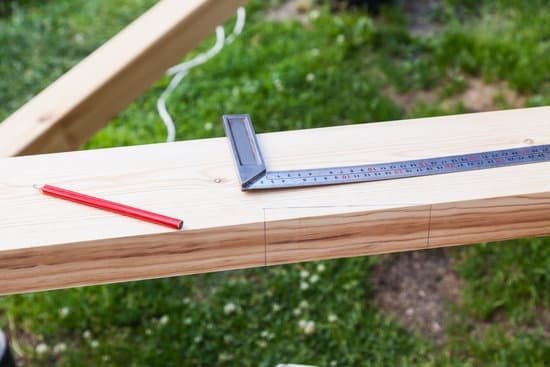Introduction
Creating a template for woodworking can be a great way to save time and ensure that your projects look professional. By using a template, you can create consistent cuts, size complex components quickly, and duplicate jointery easily. Additionally, using templates can help you make precise cuts in the required measurements without wasting material.
Once you have designed the template, you will need to use it along with other tools of woodworking such as saws, routers, or any other cutting devices you may use regularly. When used correctly, your template should give you consistent results which should match what you’re looking to achieve in your project. Depending on the type of project you are creating, templates can also be used to create complex shapes or designs that would normally take more time or effort if done by hand.
Using templates will not only help speed up the process of making your woodworking projects but also make them cleaner and more precise than they could be otherwise. Furthermore, having a set cutout makes it even easier to reproduce multiple items from the same design without deviating from the original form. Templates are great for repetitive cuts like mitered corners and curves as well; by simply swapping out different blades on a jig saw one can make repeatable curved designs for furniture or cabinets much quicker than when doing so by hand. Having precise repeatability will allow one to not only trial and error different styles but also develop their own signature styles without worrying about inconsistent measurements spoiling their product output. Finally, some templates can be re-used across multiple jobs; meaning once an initial template is developed for an item all future iterations of that item will cost less in both money and time due to faster production times resulting from pre-set cutouts ready to go at anytime!
Benefits and Advantages of Using Different Types of Wood
One of the major benefits of using different types of wood when making a template for woodworking is that each type can provide its own unique look and feel. For instance, softwoods such as pine or spruce tend to be light in color, while hardwoods like oak or cherry tend to produce a more rich and robust look. Different types of woods also provide varying textures, from coarse to fine. This can give your finished project an interesting dimension with textured patterns incorporated into the surface. Wood grain can also vary considerably between different species, providing another visually appealing characteristic for your creations. Additionally, some wood types are naturally rot-resistant, making them ideal choices for outdoor projects.
Choosing Materials for Your Template
When making a template for woodworking, it is important to choose materials that will withstand changing temperatures and humidity levels as well as repeated use. A sturdy piece of plywood or particleboard works best for this. You can also use hardwoods such as oak and maple or even medium density fiberboard (MDF). It depends on what type of woodworking projects you are doing as to which material you should select. If you’re working with complex shapes, it is helpful to make your template out of either plywood or MDF. These materials are easier to work with when cutting small pieces precisely, so they will be more accurate in the end result. If you’re using hardwoods for the woodworking project themselves, opt for those same types of wood for the template to ensure maximum accuracy. Lastly, make sure all angles are properly measured when creating your template – measuring twice or even three times before cutting allows for greater accuracy in the shape that results from your final product.
Setting Up a Mock Template to Practice With
Before jumping into creating a template for woodworking, it is important to know the basics of how to make a template. One great and safe way to practice is by setting up a mock template. The components necessary for making a mock template include: a sheet of craft foam, an X-acto knife, and a ruler or straight edge. First begin by drawing out the desired shape on the craft foam with the X-acto knife in conjunction with the ruler or straight edge to ensure precision. Once satisfied with the shape, use scissors to separate both sides cleanly along the drawn outline before finally testing out different angles and sizes of pieces that will fit inside the cutout sections of your mock template. With patience and precision, creating a successful template for woodworking can be achieved without damaging real materials!
Measuring and Marking the Layout and Design of Your Template
Before creating the template for woodworking, it is important to measure and mark out the design and layout. This will ensure that your cutouts fit together properly and that you gain perfect accuracy throughout your woodworking project. First, take accurate measurements of the areas where you will want to cut out of the wood. Be sure to use a ruler or tape measure to ensure accuracy and precision. For curved shapes, use a flexible measuring tool like a band saw or a compass.
Next, mark out any lines required for cutting or other details on your template. This can be done through pencil marks, chalk marks, scoring marks with an awl or marking knife, using scribes to create etchings in the material etc. Use a square ruler when marking straight lines and make sure any circles are accurately marked with their center point. Make sure all markings are precise before commencing any cutting work. Finally review all cuts and adjustments before transferring your template onto the workpiece using screws, clamps, pins etc as appropriate.
Safety Tips and Precautions for a Successful Woodworking Template
Woodworking is a great pastime and an incredibly fulfilling activity, but it also requires a certain level of safety to ensure that all projects run smoothly. When making any kind of template for woodwork, in particular, safety should be the first thing on your mind. To minimize risks while working with wood, here are some tips and precautions to consider:
1. Always read the instructions before beginning any project; never use tools you aren’t familiar with. Before starting work on a template for woodworking, take time to read through all instructions given, and make sure everything is understood exactly before proceeding further.
2. Invest in quality tools and appropriate gear such as gloves and protective eyewear to protect from potential injuries from splinters or chips flying off the wood as well as safety glasses if necessary.
3. Work in a clean, well-lit area and make sure all tools are properly stored away when finished for the day. This ensures that there won’t be any tripping hazards or debris around which could prove dangerous during operation of power tools or other equipment used in making templates.
4. Ensure cutting blades are sharpened properly and maintained often; dull blades can cause dangerous kickbacks when operating machinery or create irregular cuts that may not meet dimensions as intended by plans written down earlier in the project layout stages.
5. Make sure all surfaces being worked on are even and level prior to starting; this allows for a more accurate template when transferring measurements onto them without having to worry about any inconsistencies that could cause issues later down the line if not taken into consideration beforehand.
Working with Different Wood Species and Finishes
When creating a template for woodworking, it is important to take into consideration the various species of wood and finishes that may be used. Different woods can have vastly different characteristics such as grain orientation, density and color. Some woods can also significantly expand and contract with changes in temperature or humidity. It is therefore essential to consider the nature of the timber when designing a template so that it will remain consistent from project to project regardless of any potential variation in wooden species or finishes. Additionally, any cutting or joinery techniques should take into account these factors so as not to compromise the strength or aesthetics of whatever projects are being built. The use of specific tools and techniques should be considered based on the nature of the wood being used for each job, so that the finished product looks uniform and sturdy regardless of what species has been selected or what finish has been applied.
Step-by-Step Guide to Making a Woodworking Template
1. Gather all necessary tools and materials: Before you begin, it is important to gather together all of the materials and tools needed for making the woodworking template, such as a jigsaw, power drill with bits and an appropriate piece of plywood. If you are using a template made from a pattern or another source, make sure these materials are available as well.
2. Prepare the work area: It’s essential that you ensure that your work area is clean, safe, and well-lit before beginning on your project. Place drop cloths or heavy fabric on the floor due to inevitable sawdust that could be hazardous if walked on without protection. Ensure your working surface is stable and leveled.
3. Design your template: Depending on what piece of furniture or other item you’re making, design your template accordingly by drawing out the desired shape onto paper for blueprint reference. Be sure to take into account broad dimensions such as height and width when designing; also note any special shapes that either need cutouts or intricate carvings in order to create further detail so this can be marked onto the plywood with a pencil afterwards.
4. Cut the shape from plywood: Using a jigsaw with an appropriate blade size specified for cutting softwoods such as pine or maple (depending upon which type of wood you’re using), trace around the drawn design laid out in step 3 and cut it out from the material –– accounting for any carvings beforehand when cutting if needed. Working slowly will help avoid incorrect cuts where mistakes could lead to costly replacement costs later down the line; sand off any rough edges after each cut has been made until they are smooth.
5. Install bolt holes/fasteners: The final step requires drilling suitable hole sizes predetermined by sketching them onto the template itself according to your individual project design needs firstly; attach relevant bolts/other fasteners afterwards at adequate positions once completed in order to mount your finished product securely wherever required depending upon individual specifications listed by clients iif applicable prior to sale/distribution thereafter (purchase these separately for best results).
Tips and Tricks for Storing and Preserving Your Template
When making a template for woodworking, there are several steps to ensure that the template is stored and preserved correctly. The first step is to make sure the template is made of a material that can withstand long-term storage without warping or deteriorating. Plywood or MDF make excellent template materials. Additionally, it is important to protect the edges of the template from splintering or cracking by sealing them with an appropriate finish such as a clear varnish or paint. This also helps prevent warping over time.
Storing the template correctly will prolong its life. Ideally, store templates in cool, dry areas such as in a cupboard, closet, or tool box. Place the templates on a flat surface away from direct sunlight and other sources of heat and moisture. Also be sure to label each template clearly with its intended use and where it was stored after each use so it can be easily retrieved later on.
In order to preserve your templates down the line, try to avoid exposing them to adhesive residue from labels or marking pens which may damage your templates over time. Clean any residues off your templates using mineral spirits before storing them away; but do not store near petrol products as fumes may cause damage over time too! Finally avoid folding your templates as this may weaken their structure over time; instead roll them up if needed for easy transportation and better preserving them for future projects!
Final Thoughts on Creating a Template for Woodworking
Creating a template for woodworking can often seem like an intimidating task, but it doesn’t have to be. By taking the time to carefully plan and measure your material, choosing a reliable template material, and using sharp cutting tools, you can easily create precise and repeatable cuts every time. With this skill set at your disposal, your next project will be well within reach.
When creating templates for woodworking projects, remember that accuracy is key. Precision measurements are essential; take the time to make sure all measurements are correct before you commit them to a template. It’s also important to consider the various cutting tools available; choose sharp blades and router bits so that the finished product looks smooth and professional. Additionally, pay special attention when selecting a template material; use something sturdy like acrylic or hardboard so that any patterns made with it remain accurate through multiple uses. Finally, practice makes perfect! Spend some time getting used to following the template in order to get comfortable with its use before you start an actual project using it as a guide.
The same careful consideration taken when creating the template should apply during its use as well. Make sure that all measurements continue to be precise – check your cuts with calipers or rulers – and clean up any rough edges before continuing further into your project. Lastly, mark or label each part of your template according to the type of cut it allows (for example: “45° angle cut” or “4-inch hole saw”). Taking these steps will help streamline production later on if a similar job needs re-creating in the future – one less thing to worry about! With careful planning and execution, anyone can easily make an accurate and sturdy template while conquering their next woodworking task.

Hi everyone! I’m a woodworker and blogger, and this is my woodworking blog. In my blog, I share tips and tricks for woodworkers of all skill levels, as well as project ideas that you can try yourself.





